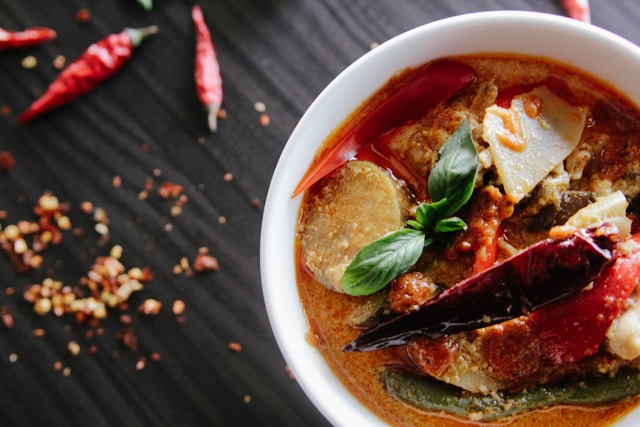Table of Contents
- Introduction
- What is Chili?
- Chili Recipe Ingredients
- Flavor Boosters and Variations
- How to Make Chili (Step-by-Step)
- Chili Toppings and Sides
- Chili Tips and Tricks
- Nutrition and Health Benefits of Chili
- Conclusion
Introduction
There’s nothing quite like a warm, hearty bowl of chili on a cold day. This iconic dish has the power to comfort and satisfy with its rich flavors and diverse ingredients. In this comprehensive guide, we’ll cover everything you need to know to make the ultimate chili recipe that will have your family and friends asking for seconds (and thirds!).
What is Chili?
Before we dive into the recipe, let’s start with a basic definition. Chili is a spicy stew that typically contains chili peppers or chili powder, meat (such as beef, turkey, or chicken), tomatoes, beans, and a blend of aromatic vegetables and spices. It has its origins in Tex-Mex and Mexican cuisine, with influences from Native American food traditions.
While the core ingredients remain the same, there are many regional variations of chili. For example:
- Texas-style chili: This classic version is made with beef, chili peppers, and spices, without any beans or tomatoes.
- Cincinnati-style chili: A unique twist that includes cinnamon, cloves, and often chocolate, served over spaghetti noodles.
- Vegetarian/vegan chili: Meat-free versions that rely on beans, vegetables, and meat substitutes for protein.
- White chicken chili: A creamy, broth-based chili made with white beans, chicken, and green chiles.
No matter the variation, all chilies share a few things in common: they’re hearty, flavorful, and incredibly satisfying.
Chili Recipe Ingredients
The beauty of chili is that it’s a dish that can be customized to suit your taste preferences. However, there are some core ingredients that form the base of most chili recipes:
- Meat: Ground beef is a classic choice, but you can also use ground turkey, chicken, or meat substitutes for a vegetarian/vegan option.
- Chili peppers or chili powder: These provide the signature heat and flavor. Common options include ancho, chipotle, and jalapeño peppers, or a blend of chili powders.
- Tomatoes: Diced, crushed, or in sauce form, tomatoes add a bright acidity and body to the chili.
- Beans: Kidney, black, or pinto beans are popular choices, providing protein, fiber, and heartiness.
- Aromatics: Onions, garlic, and bell peppers form the flavorful base.
- Spices: A blend of cumin, oregano, paprika, and cayenne pepper is common, but you can experiment with other spices too.
- Liquids: Broth (beef or chicken), beer, or coffee can be used to thin out the chili and add depth of flavor.
- Thickeners: Masa harina (corn flour) or cornmeal can help thicken the chili if desired.
Flavor Boosters and Variations
Once you have the base ingredients covered, you can take your chili to the next level with these flavor boosters and variations:
- Bacon or chorizo: Adding a few slices of crispy bacon or some spicy chorizo sausage can infuse the chili with a delicious smokiness.
- Different chili peppers: Experiment with ancho, chipotle, habanero, or other varieties of chili peppers for unique flavors.
- Cocoa powder or cinnamon: A touch of cocoa powder or cinnamon can add depth and warmth to the chili.
- Wine or liquor: A splash of red wine, beer, or even a shot of tequila or bourbon can enhance the flavors.
- Corn or hominy: Adding some kernels of fresh or canned corn, or chewy hominy, provides texture and sweetness.
- Acid: A squeeze of lime juice or a splash of vinegar can help brighten and balance the rich flavors.
Feel free to get creative and make the chili your own by incorporating different ingredients and flavors!
How to Make Chili (Step-by-Step)
Now that we’ve covered the ingredients, let’s walk through the step-by-step process of making a classic chili recipe:
- Brown the meat: In a large pot or Dutch oven, cook the ground beef (or meat of your choice) over medium-high heat until browned and crumbled. Drain excess fat, if desired.
- Sauté the aromatics: Add the diced onions, garlic, and bell peppers to the pot and sauté for a few minutes until fragrant and softened.
- Toast and bloom the spices: Create a small open space in the center of the pot and add the chili powder, cumin, oregano, and any other dried spices you’re using. Toast them for a minute or two to release their flavors, then stir everything together.
- Add remaining ingredients: Pour in the diced tomatoes (with their juices), beans, broth or other liquid, and any additional ingredients you’re using (like beer, coffee, or cocoa powder).
- Simmer the chili: Bring the chili to a boil, then reduce the heat and let it simmer for at least 30 minutes, or up to a few hours, stirring occasionally. The longer it simmers, the more the flavors will meld and develop.
- Thicken (optional): If you prefer a thicker chili consistency, you can stir in a bit of masa harina or cornmeal at the end of cooking. Start with a small amount (1-2 tablespoons) and add more as needed.
- Adjust seasoning: Taste the chili and adjust the seasoning as needed, adding more salt, pepper, or other spices to your liking.
For a time-saving method, you can also make chili in a slow cooker or Instant Pot. Simply brown the meat and aromatics first, then transfer everything to the slow cooker or Instant Pot and let it cook for a few hours.
Chili Toppings and Sides
While chili is delicious on its own, it’s even better when topped with a variety of flavorful garnishes and served alongside some classic sides. Here are some tasty options to consider:
Toppings:
- Shredded cheese (cheddar, Monterey Jack, or a Mexican blend)
- Sour cream or Greek yogurt
- Diced avocado or guacamole
- Sliced jalapeños
- Chopped green onions or cilantro
- Crushed tortilla chips or crackers
- Hot sauce (like Cholula or Tapatio)
Sides:
- Cornbread (try it with honey butter or jalapeño cheddar cornbread)
- Tortilla chips or Fritos
- Warm flour tortillas or cornbread muffins
- A fresh green salad or caesar salad
- Buttered corn on the cob
Don’t be afraid to get creative and offer a variety of toppings and sides so that everyone can customize their chili bowls to their liking.
Chili Tips and Tricks
Over the years, chili aficionados have picked up a few handy tips and tricks for making the best chili possible:
- Controlling spice level: If you want a milder chili, remove the seeds and membranes from the chili peppers before adding them. For more heat, leave them in or add extra chili powder. You can also offer hot sauce on the side.
- Vegetarian/vegan chili ideas: Replace the meat with extra beans, lentils, or meat substitutes like crumbled tempeh or soy chorizo. Use vegetable broth instead of beef or chicken broth.
- Storing and freezing: Chili is one of those dishes that tastes even better the next day after the flavors have had time to meld. It also freezes beautifully, so make a big batch and freeze portions for easy future meals.
- Thickening runny chili: If your chili turns out too thin or soupy, you can thicken it by mashing some of the beans against the side of the pot, or stirring in a slurry made with masa harina or cornmeal and water.
- Award-winning competition chili secrets: For a truly next-level chili, some competition chefs swear by using a blend of multiple types of chili powders, adding a touch of coffee or chocolate, or incorporating smoky ingredients like chipotle chiles or smoked paprika.
Nutrition and Health Benefits of Chili
In addition to being incredibly delicious, chili is also a nutritious and relatively healthy meal option. Here are some of the key benefits:
- Protein: The meat (or beans/lentils in vegetarian versions) provides a good source of protein to keep you feeling full and satisfied.
- Fiber: Thanks to the beans and vegetables, a hearty bowl of chili can pack in a significant amount of dietary fiber, which is essential for good digestion and heart health.
- Vitamins and minerals: Depending on the exact ingredients used, chili can provide valuable nutrients like vitamin C (from tomatoes and peppers), iron (from meat and beans), and antioxidants (from spices like chili powder and cumin).
- Adjustable for dietary needs: Chili is a versatile dish that can be easily modified to accommodate various dietary restrictions or preferences, such as gluten-free, dairy-free, low-carb, or plant-based diets.
To boost the nutrition even further, consider adding extra veggies like diced carrots, spinach, or zucchini to your chili. You can also opt for leaner cuts of meat or use plant-based protein sources like lentils or quinoa.
Conclusion
There’s no denying that a steaming hot bowl of chili is one of the most comforting and satisfying meals around. With this comprehensive guide, you now have all the knowledge and tips you need to make the ultimate chili recipe that will please even the pickiest of eaters.
Remember, the key to a truly outstanding chili is using high-quality ingredients, allowing the flavors to simmer and meld together, and customizing the recipe to your personal taste preferences. Don’t be afraid to experiment with different combinations of meats, beans, spices, and toppings to find your perfect chili blend.
So what are you waiting for? Gather your ingredients, fire up the stove, and get ready to impress your friends and family with a chili recipe that’s sure to become a new favorite. Enjoy!

